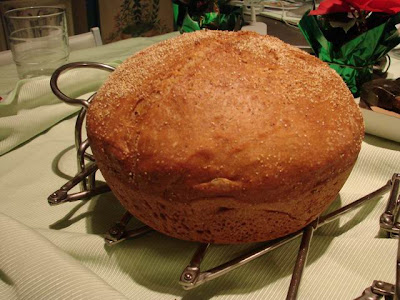This is the latest and perhaps greatest, if not last, variation on the theme of no-knead "breading" for The Recipeless Cook. It is the coup de maitre of taking one half quantity of all purpose flour, and one half whole wheat (stoneground organic no less), and making the perfect bread out of the perfect compromise. It's one of my best variations. Why do this? Why not go all the way, with one flour type or another? Well....
Simply put, I got tired of having doorstops for supper. It's certainly healthier to go 100% whole wheat on the flour, and particularly so if using stoneground organic. But no matter what you try, you will end up with a much flatter, more dense and harder bread, than you otherwise would. Since all white flour is not a very healthy diet, I decided something healthier, and more challenging was in order. Look at the photo above and see if you agree. It is a bread made with half stoneground, organic "integral wheat bread" flour (aka whole grain whole wheat), half plain all purpose white flour (you could certainly use purpose-built white bread flour). It's a slow rise of about 18 hours, as described in my other no-knead recipes. To keep the bread fluffy and the crust soft, I add more yeast than prescribed, and throw in some gluten flour and (soya) milk powder. These last two are optional if you don't have them, but recommended for best results.
Keep It Simple
The no-knead bread recipe is more than a recipe. It's a lifestyle. It's taken a lot of the cachet out of artisan bakery bread and put it back in the hands of home cooks, where it belongs. It's made having fancy gadgets, like puce-colored stand mixers, unnecessary. It's simple enough to be understood by a 5 year old girl, powerful enough to change lives and their diets. It's a panacea in these economic times, where room to manoeuver is getting tighter all the time. Which is why, while it works, it works best if you create the bread on an ongoing, regular basis. Make it a permanent part of your routine, and you will likely benefit in spades. When you see you're getting down to a few slices, sometime before bedtime, prepare a new bread for the next day. It only takes five minutes. Ultimately, you can control what you eat by controlling what goes into your bread, and control costs by chopping your bread budget to a fraction of what it might have been, if you buy commercial.
By all means, experiment with the variations of the no-knead I have written about on this blog. But keep in mind that the simpler, is usually the better. Less things to go wrong. Example... creating a faux sourdough, as I write about in another recipe, can give a nice sour flavour and chewiness to the crumb and crust that a regular recipe won't produce. But it interferes with the rising process, and eventually creates a much more dense bread that can come out with a terribly glutinous core.
Ingredients
2 c all purpose (or bread) flour (aka white flour)
2 c whole wheat flour
1/2 t yeast
2 t salt
2 T gluten powder
2 T soya milk powder
2 1/4 c water
 You can find more details on the ingredients (ie. gluten powder and soya powder) and the preparation for this bread in my other no-knead recipes (ie. 100% whole wheat no knead). The principle is the same, just the ingredients change. Some basic rules to go by:
You can find more details on the ingredients (ie. gluten powder and soya powder) and the preparation for this bread in my other no-knead recipes (ie. 100% whole wheat no knead). The principle is the same, just the ingredients change. Some basic rules to go by:- You use 1/2 c of tepid water per cup of flour. (n.b. The addition of the gluten and milk powder requires an additional 1/4 c)
- You mix the ingredients first, in a large bowl. You can use your hands, a spatula, or as I currently prefer, a sturdy metal flatware spoon. (Hands can help you feel tiny details, like where the flour clumps. But I prefer a spoon, as it is more hygenic and gives greater control). Start in the centre, mixing vigorously, and allowing the edge flour to automatically blend in. Then scrape along the edge of the bowl to blend in the remaining flour, turning the bowl as you go. Then (ie. using the spoon), turn the entirety of the dough as many times as necessary (avoid mashing it if possible), to allow the wetter parts of the dough to absorb the stray quantity of flour. Do this until all the flour is absorbed.
- Squeeze a plastic bag tightly over the bowl, and place it in either the microwave oven (with a glass of hot water), or better still, your regular large oven (along with a pot full of boiling water). This will increase the humidity in the oven environment, to allow a fuller rise. Let sit 18 hours in the oven, then proceed as instructed in the above (whole wheat) recipe. (As described, you will be baking it in a covered pot at 350F for about 1 1/2 hours).











0 comments:
Post a Comment